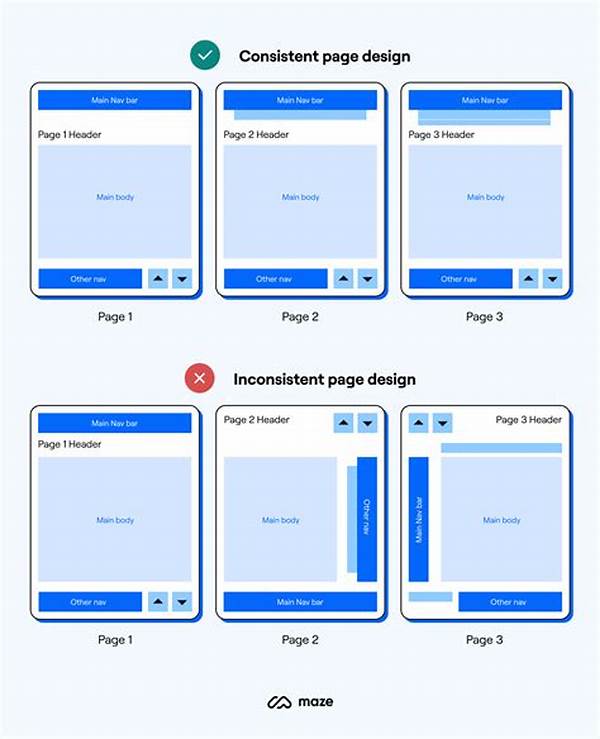Creating a seamless and user-friendly interface requires a strong grasp of consistent UI design principles. These principles serve as essential guidelines for developers and designers aiming to provide users with a smooth and intuitive experience. In the evolving world of user interface design, consistency ensures that users can predict interaction patterns, leading to a more satisfying user experience. Let’s delve into the essential principles of consistent UI design, exploring how they contribute to crafting harmonious and effective interfaces.
Read Now : Effective Color Coordination Techniques
Understanding Consistent UI Design
At the heart of user interface design lies consistency, which plays a crucial role in enhancing the user experience. When users interact with a digital product, familiar patterns and predictable elements create a sense of comfort and reliability. The principles of consistent UI design emphasize the importance of uniformity across various design elements like typography, color schemes, button styles, and navigation structures. By adhering to these principles, designers ensure that users can easily navigate and engage with the interface, minimizing cognitive load and confusion.
Consistent UI design eliminates unnecessary guesswork, enabling users to focus on their tasks rather than figuring out how things work. Designers achieve this by maintaining functional and visual consistency throughout the interface, ensuring that similar elements behave and appear similarly. This not only enhances usability but also strengthens brand identity, as users associate the consistent UI with the brand’s values and ethos. The principles of consistent UI design, therefore, serve as the foundation for creating interfaces that are not only functional but also aesthetically pleasing and easy to use.
Key Elements of Consistent UI Design
1. Visual Consistency: The principles of consistent UI design demand that visual elements such as color palettes, fonts, and icons remain uniform throughout the interface. This visual coherence helps users intuitively connect different parts of the interface.
2. Functional Consistency: Ensuring that interactive elements like buttons and menus behave similarly across the interface forms a core part of the principles of consistent UI design. This consistency aids in setting user expectations and reducing learning curves.
3. Recognition Over Recall: Designing interfaces that allow users to recognize patterns instead of recalling details aligns with the principles of consistent UI design, ensuring that the user journey is smooth and intuitive, lessening the mental effort required.
4. Predictable Navigation: According to the principles of consistent UI design, navigation should be intuitive and predictable. Consistency in navigational elements enhances ease of use and satisfaction by helping users quickly find necessary information.
5. Feedback and Response: The principles of consistent UI design emphasize the importance of feedback. Immediate and coherent responses to user actions build trust and confidence in the interface’s functionality.
Implementing Consistent UI Design
Adopting the principles of consistent UI design requires a meticulous approach to ensure that all elements of the interface work in harmony. A good starting point is establishing a design system or style guide that outlines every aspect of the visual and functional components of the interface. This documentation acts as a reference for designers and developers, ensuring that new or updated features adhere to a uniform standard. By maintaining a shared understanding, teams can collaboratively work towards a consistent UI that resonates with users.
Consistency should not be misconstrued as monotony. While it’s crucial to maintain uniformity, designers should also strive for a balance between consistency and creativity. Applying the principles of consistent UI design effectively means incorporating flexibility that allows for innovation and adaptability, while ensuring that the overall structure and function remain coherent. By following these principles, design teams can create interfaces that are not only reliable but also engaging and dynamic.
Advantages of Consistent UI Design
1. Enhanced User Experience: The principles of consistent UI design improve user satisfaction by ensuring predictability and ease of use.
2. Reduced Training Time: A familiar interface decreases the learning curve for users.
3. Increased Efficiency: Users can perform tasks faster when interacting with a consistently designed UI.
4. Stronger Brand Identity: Consistency reinforces brand recognition across different products and platforms.
5. Fewer User Errors: By following the principles of consistent UI design, the likelihood of users making errors decreases, fostering a more reliable experience.
Read Now : Achieving Brand Coherence With Color
6. Improved Accessibility: Consistent design principles ensure that interfaces are accessible to a wider audience, accommodating diverse needs.
7. Greater Trust: Trust is built when users feel confident navigating an interface without surprises.
8. Simplicity and Clarity: The principles of consistent UI design emphasize simplicity, making the interface more straightforward for all users.
9. Boosted Engagement: Consistent interfaces tend to retain users with their intuitive and pleasant experiences.
10. Seamless Updates: Adhering to consistent design principles facilitates smoother transitions during updates or redesigns.
Exploring the Art of Consistency
The principles of consistent UI design extend beyond mere aesthetics; they embody a thoughtful strategy to enhance user engagement and satisfaction. In today’s fast-paced digital environment, users have little patience for interfaces that are difficult to navigate or inconsistent in their behavior. Adopting these principles not only guides users effortlessly through an interface but also significantly enhances their overall experience.
When users encounter an interface, their primary desire is to accomplish tasks efficiently without unnecessary friction. Consistent UI design plays a pivotal role in fulfilling this need by providing a predictable environment where users can interact with the interface seamlessly. This level of predictability is achieved by adhering to established design patterns and conventions, ensuring users do not have to learn new interaction models each time they use a different feature. By prioritizing these principles, organizations are better positioned to deliver interfaces that are both functional and appealing, meeting user expectations and driving long-term engagement.
The Role of Consistency in Modern Design
Adopting the principles of consistent UI design is not only about aligning with user expectations but also about creating an emotional connection with users. Consistency in design builds trust, as users are more likely to engage with a product they find reliable and straightforward. This emotional attachment can lead to brand loyalty, as users identify with the consistent elements of the interface, associating them with positive experiences.
Moreover, consistent UI design fosters a sense of professionalism and attention to detail, reflecting the brand’s commitment to delivering quality and coherence. In an era where user-centered design is paramount, embracing consistency allows designers to focus on crafting experiences that resonate deeply with users. Keeping these principles at the forefront of design processes ensures that the final product is not only practical and efficient but also inspiring and enjoyable for users.
Conclusion: Harnessing Consistency for Success
In conclusion, the principles of consistent UI design are fundamental in creating effective and user-friendly interfaces. By ensuring uniformity across different elements, designers can significantly enhance the user experience, leading to increased satisfaction and productivity. Adhering to these principles not only benefits users but also supports brand recognition and loyalty. Consistency aids in reducing cognitive load, allowing users to focus on their tasks without unnecessary interruptions.
Ultimately, the principles of consistent UI design are crucial for success in the competitive digital landscape. By fostering predictability and reliability, these principles contribute to the creation of interfaces that are not only functional but also aesthetically appealing and enjoyable to use. As designers continue to innovate, keeping these principles in mind will ensure that their creations meet users’ evolving needs while maintaining a strong connection to the brand’s identity and goals.



